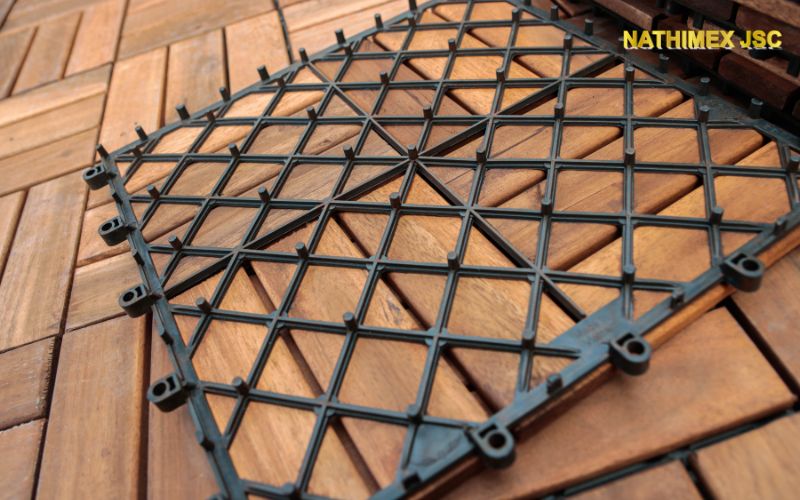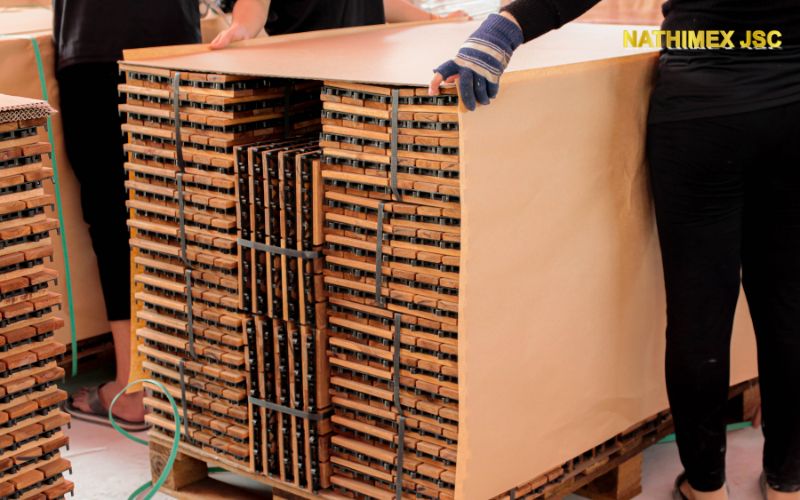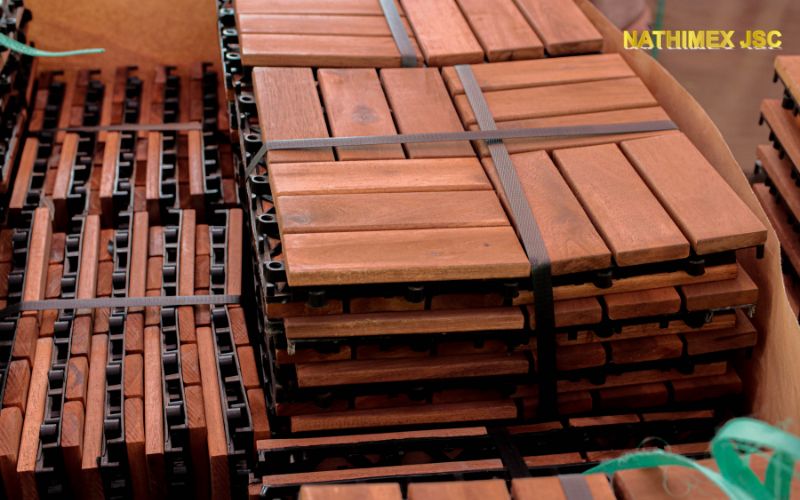When shipping products overseas, it's crucial to ensure that they meet the highest quality standards to avoid any issues with customers and customs officials. Nathimex, a leading manufacturer of wood deck tiles, has announced its commitment to ensuring that its products meet the highest quality standards before exporting abroad. The company has outlined a set of quality criteria that it uses to inspect its wood deck tiles before they are shipped overseas.
1. The durability of products
Durability is an important quality criterion that manufacturers and consumers consider when evaluating a product. First of all, products must be made with high-quality materials that can withstand wear and tear over time. The materials should be durable and resistant to damage from environmental factors such as temperature, moisture, and sunlight. Secondly, products must be designed and constructed in a way that maximizes their durability. This includes using sturdy construction methods and materials, minimizing the use of weak points, and ensuring that all components are securely fastened.
Continuingly, products must undergo performance testing to ensure that they can withstand normal use over an extended period. This includes testing for resistance to impact, vibration, and other types of wear and tear. Another criterion is maintenance requirements. Products must be designed with maintenance requirements in mind. If regular maintenance is required to maintain the product's durability, manufacturers must provide clear instructions and guidelines for proper maintenance.
The final is warranty. Specifically, a warranty is a guarantee from the manufacturer that the product will remain durable for a specified period. The warranty should provide clear details on what is covered, how long the coverage lasts, and what actions the manufacturer will take if the product fails to meet durability standards. By adhering to these durability standards, manufacturers can ensure that their products meet the highest quality standards, are durable and reliable, and provide long-lasting performance for consumers.
This helps to build trust with customers, minimize the risk of legal liability, and increase the overall quality and value of the product. Durability is one of the primary quality criteria that Nathimex focuses on. The company uses high-quality materials and advanced manufacturing processes to ensure that its wood deck tiles are built to last. This is particularly important for products that will be exposed to the elements, such as rain, wind, and sun, as they need to be able to withstand these conditions without deteriorating over time.

2. Environmental sustainability
In addition to durability, environmental sustainability is an important quality criterion that is increasingly being considered by manufacturers, consumers, and regulators. Manufacturers can ensure that their products meet the highest environmental standards, minimize their environmental impact, and comply with relevant regulations by adhering to these environmental sustainability standards. This helps to build trust with customers, minimize the risk of legal liability, and demonstrate the company's commitment to environmental sustainability.Here are some common standards to evaluate the environmental sustainability of products:
+Material selection: Products must be made from sustainable materials that minimize their environmental impact. This includes using materials that are renewable, recycled, or biodegradable, as well as minimizing the use of materials that are harmful to the environment.
+ Energy efficiency: Products must be designed to be energy-efficient and minimize energy consumption during use. This includes designing products to operate on low power, using energy-efficient components, and optimizing the product's performance to minimize energy use.
+ Carbon footprint: Products must be designed to minimize their carbon footprint throughout their lifecycle, from production to disposal. This includes minimizing greenhouse gas emissions, reducing waste, and promoting recycling and reuse.
+ Life cycle analysis: Products must undergo a life cycle analysis to evaluate their environmental impact throughout their lifecycle. This includes assessing the environmental impact of the product's production, transportation, use, and disposal.
+Compliance with regulations: Products must comply with relevant environmental regulations, such as those governing the use of hazardous substances, waste management, and emissions. This includes obtaining necessary permits, conducting regular inspections and monitoring, and reporting on environmental impact.


3. Safety in use
Another important quality criterion for inspecting products is safety in use. Product safety is a critical concern for manufacturers, distributors, retailers, and consumers. To evaluate the safety of products in use, it's important to consider several criteria that can affect the safety of the product. Initially, the first criterion to evaluate the safety of products in use is to identify any potential hazards associated with the product. This includes physical hazards such as sharp edges, electrical hazards, chemical hazards such as toxic substances, and biological hazards such as bacteria or viruses.
Second, products should be designed and manufactured to be used safely. This includes providing clear and easy-to-understand instructions for use, as well as warnings and precautions to minimize the risk of injury or harm. Next, the durability of a product is essential to its safety. Products that are designed to wear out quickly or that are not built to withstand normal use can become dangerous, leading to injury or harm. Then, products that require regular maintenance or servicing must be designed with that in mind. If maintenance is not performed regularly, the product may become unsafe to use. Subsequently, the quality of the product must be consistent to ensure that it remains safe to use over time.
Quality control measures, such as testing and inspection, are essential to ensure that products remain safe during their useful life. Afterward, monitoring user feedback is an essential criterion for evaluating the safety of products in use. It helps manufacturers to identify potential safety issues that may arise in real-world use and make necessary changes to improve the product's safety. Last of all, by evaluating products based on these criteria, manufacturers can ensure that their products are safe to use, minimize the risk of injury or harm to users, and build a positive reputation for the company.
Accordingly, Nathimex JSC ensures that its wood deck tiles are safe for use, with no sharp edges or other hazards that could cause injury. The company also follows strict quality control procedures to ensure that all of its products meet safety standards.


4. Packaging & Labeling
Packaging and labeling are crucial components of the quality criteria used in inspecting products before exporting abroad. Here are some common standards for packaging and labeling that are important to consider including protection, and sustainability. Packaging must be designed to protect the product during transport, handling, and storage. It should provide adequate cushioning, support, and protection against damage from shocks, vibrations, or impacts. Secondly, packaging materials should be environmentally sustainable and not harmful to the environment.
Manufacturers should use eco-friendly packaging materials that can be recycled, reused, or biodegraded. Thirdly, packaging and labeling must comply with relevant regulations and standards in the destination country. These include requirements for labeling, warning symbols, and information on product composition, weight, and other relevant details.
Next, the labeling on the product must be clear and legible, and in the language of the destination country. It should provide all necessary information about the product, such as its intended use, ingredients, and potential hazards. Subsequently, the labeling on the product should be accurate and truthful. It should not contain false or misleading information that could mislead consumers or regulators. Finally, packaging and labeling should be consistent across all products in a given shipment. This includes consistency in design, labeling, and packaging materials used.
By adhering to these packaging and labeling standards, manufacturers can ensure that their products are well-protected during transport, comply with relevant regulations, and are clearly and accurately labeled for consumers. This helps to minimize the risk of legal liability, build trust with customers, and ensure that products meet the highest quality standards before being exported abroad.
Therefore, packaging and labeling are also key quality criteria for Nathimex. The company takes care to package its wood deck tiles in a way that protects them during shipping and ensures that they arrive in good condition. The company also includes clear and accurate labeling on its products to help customers identify the product and understand its features and benefits.




5.Wood quality
Finally, wood quality is an essential quality criterion for Nathimex. The company uses high-quality wood that is selected for its strength, durability, and beauty. This ensures that its wood deck tiles are not only functional but also aesthetically pleasing, enhancing the look and feel of any outdoor space. Several standards can be used to evaluate the quality of wood before exporting it abroad. Here are a few examples:
+ Moisture content: The moisture content of the wood is an important factor in determining its quality. Excessive moisture can cause the wood to warp, crack, or decay over time. The acceptable moisture content will depend on the type of wood and its intended use, but generally, a range of 6-12% is recommended.
+ Grade: Wood is graded based on its appearance, strength, and other factors. There are several grading systems in use, including the National Hardwood Lumber Association (NHLA) grading system in the United States and the European Grading system (EN 1611-1). The grading system will depend on the type of wood and the country of origin.
+ Size and dimension: The size and dimension of the wood are important factors in determining its quality. The wood should be cut to the correct size and dimension to ensure that it meets the requirements of the importer. It's important to ensure that the wood is free from any defects or damage that could compromise its strength and integrity.
+ Sustainability: Sustainable wood practices are increasingly important in the global marketplace. It's important to ensure that the wood is sourced from sustainably managed forests and that it meets the environmental and social standards of the importing country.
+ Chemical treatments: If the wood has been treated with chemicals, it's important to ensure that it meets the importing country's regulations for chemical content and labeling.
+ Packaging and labeling: The wood should be packaged in a way that protects it from damage during transit and is labeled with all the necessary information, including species, grade, size, and country of origin.


These are just a few of the standards that can be used to evaluate wood quality for export. It's important to work with experts in the field to ensure that all relevant standards and regulations are met before exporting wood abroad.
To wrap up, by prioritizing these quality criteria, Nathimex can produce wood deck tiles that meet the needs of customers around the world. Whether you are looking for durability, environmental sustainability, safety, packaging, labeling, or wood quality, Nathimex's wood deck tiles are sure to exceed your expectations.
